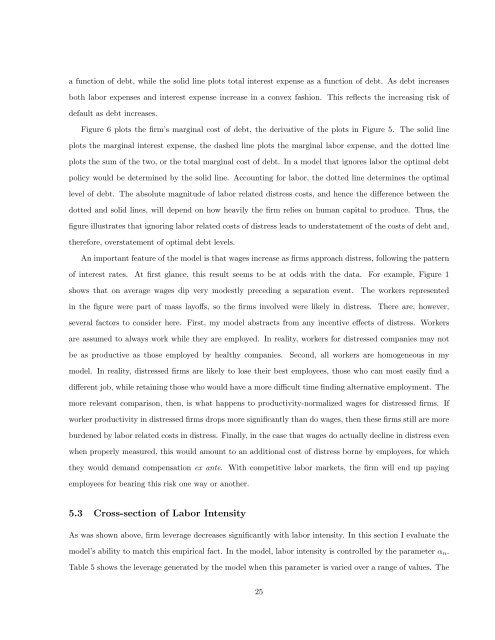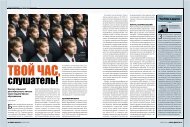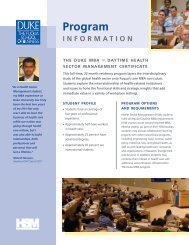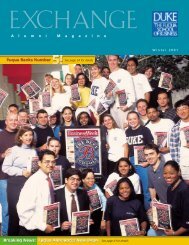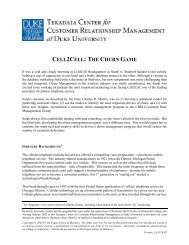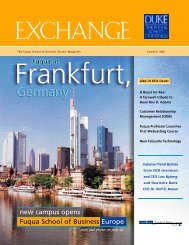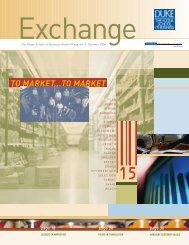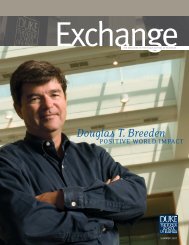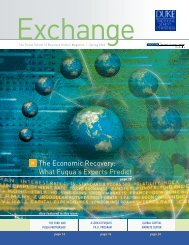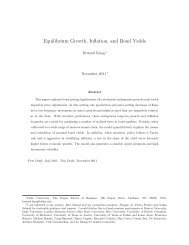A Structural Model of Human Capital and Leverage - Duke ...
A Structural Model of Human Capital and Leverage - Duke ...
A Structural Model of Human Capital and Leverage - Duke ...
You also want an ePaper? Increase the reach of your titles
YUMPU automatically turns print PDFs into web optimized ePapers that Google loves.
a function <strong>of</strong> debt, while the solid line plots total interest expense as a function <strong>of</strong> debt. As debt increases<br />
both labor expenses <strong>and</strong> interest expense increase in a convex fashion. This reflects the increasing risk <strong>of</strong><br />
default as debt increases.<br />
Figure 6 plots the firm’s marginal cost <strong>of</strong> debt, the derivative <strong>of</strong> the plots in Figure 5. The solid line<br />
plots the marginal interest expense, the dashed line plots the marginal labor expense, <strong>and</strong> the dotted line<br />
plots the sum <strong>of</strong> the two, or the total marginal cost <strong>of</strong> debt. In a model that ignores labor the optimal debt<br />
policy would be determined by the solid line. Accounting for labor, the dotted line determines the optimal<br />
level <strong>of</strong> debt. The absolute magnitude <strong>of</strong> labor related distress costs, <strong>and</strong> hence the difference between the<br />
dotted <strong>and</strong> solid lines, will depend on how heavily the firm relies on human capital to produce. Thus, the<br />
figure illustrates that ignoring labor related costs <strong>of</strong> distress leads to understatement <strong>of</strong> the costs <strong>of</strong> debt <strong>and</strong>,<br />
therefore, overstatement <strong>of</strong> optimal debt levels.<br />
An important feature <strong>of</strong> the model is that wages increase as firms approach distress, following the pattern<br />
<strong>of</strong> interest rates. At first glance, this result seems to be at odds with the data. For example, Figure 1<br />
shows that on average wages dip very modestly preceding a separation event. The workers represented<br />
in the figure were part <strong>of</strong> mass lay<strong>of</strong>fs, so the firms involved were likely in distress. There are, however,<br />
several factors to consider here. First, my model abstracts from any incentive effects <strong>of</strong> distress. Workers<br />
are assumed to always work while they are employed. In reality, workers for distressed companies may not<br />
be as productive as those employed by healthy companies. Second, all workers are homogeneous in my<br />
model. In reality, distressed firms are likely to lose their best employees, those who can most easily find a<br />
different job, while retaining those who would have a more difficult time finding alternative employment. The<br />
more relevant comparison, then, is what happens to productivity-normalized wages for distressed firms. If<br />
worker productivity in distressed firms drops more significantly than do wages, then these firms still are more<br />
burdened by labor related costs in distress. Finally, in the case that wages do actually decline in distress even<br />
when properly measured, this would amount to an additional cost <strong>of</strong> distress borne by employees, for which<br />
they would dem<strong>and</strong> compensation ex ante. With competitive labor markets, the firm will end up paying<br />
employees for bearing this risk one way or another.<br />
5.3 Cross-section <strong>of</strong> Labor Intensity<br />
As was shown above, firm leverage decreases significantly with labor intensity. In this section I evaluate the<br />
model’s ability to match this empirical fact. In the model, labor intensity is controlled by the parameter αn.<br />
Table 5 shows the leverage generated by the model when this parameter is varied over a range <strong>of</strong> values. The<br />
25


